Korowai on TV: the naked truth
Why an indigenous people takes their clothes off for cash,
and what it reveals about culturally complex hopes and dreams
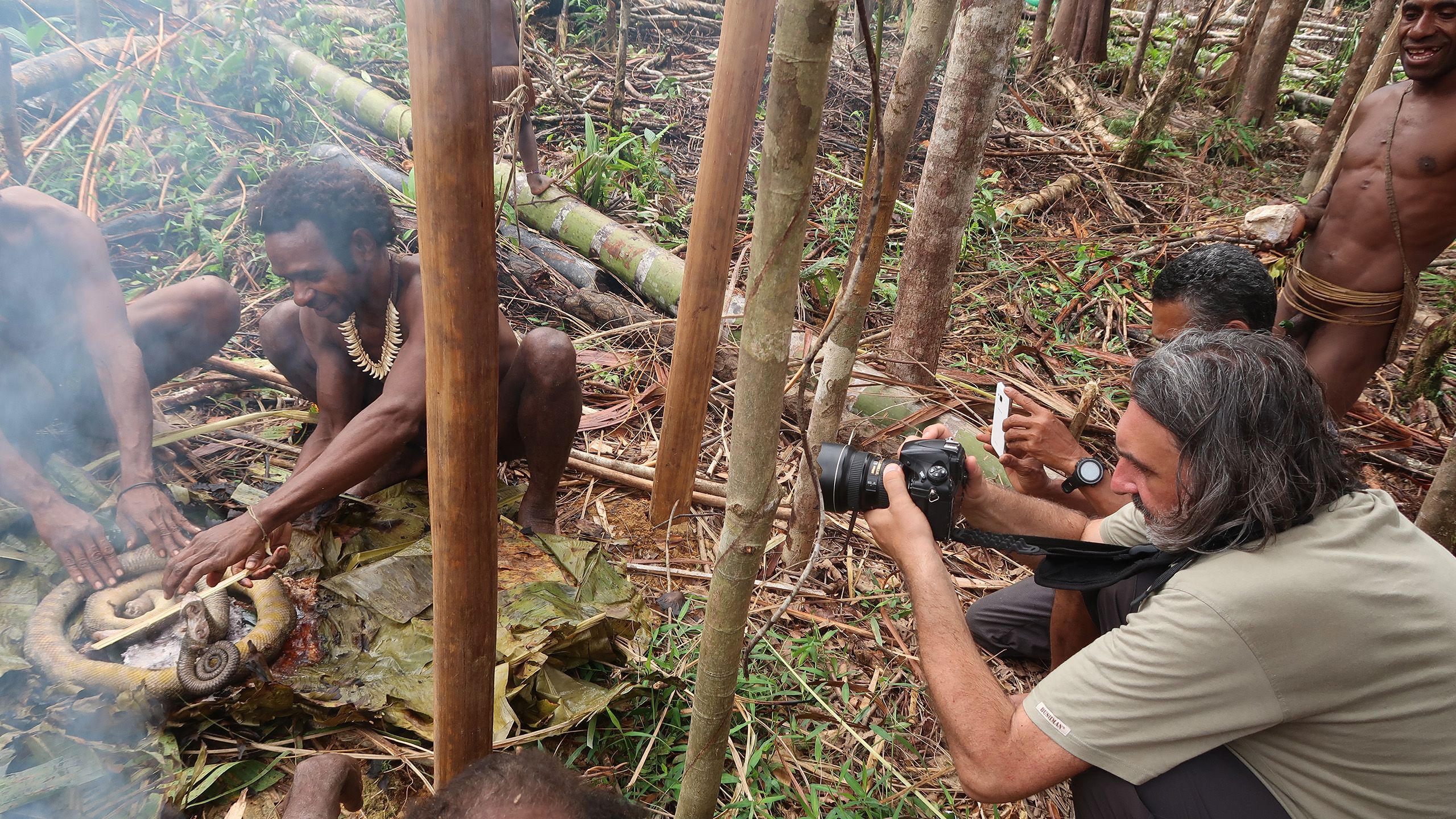
Impact at a glance
- Dr Rupert Stasch gained unique insights into the Korowai people of Indonesian Papua through three years of immersive fieldwork.
- He studies how Korowai, as the focus of over 50 television documentaries, regularly ‘perform’ in line with filmmakers’ required stereotypes in order to earn money.
- Stasch’s work with makers of the BBC Two series My Year with the Tribe resulted in it being the first widely-seen show to depict Korowai people’s true situation and changing lifestyles.
- International audiences now benefit from a more accurate understanding of the Korowai and other indigenous people in similar circumstances.
- Stasch has published a book and 30 articles about Korowai social life, their patterns of speech, and their meetings with tourists.
“As an anthropological study of how western film crews have grown increasingly desperate to find just one tribe living deep in any jungle - living in trees, wearing penis-gourds and the rest - and to pay handsomely for the footage, no matter how staged, it was a revelation.”
Euan Ferguson, reviewing My Year with the Tribe for The Guardian
A MEDIA PHENOMENON
Rupert Stasch is a world authority on Korowai people of Indonesian Papua. An anthropologist in the University of Cambridge’s Department of Social Anthropology, he has immersed himself in Korowai culture since 1995 - living with families, following their activities, and learning their language.
He is not alone in his fascination. Since 1986, over 50 television shows have been made about Korowai by production companies from across the globe. Virtually all of them depict Korowai as living without clothes, and many show them living in super-high treehouses at the very top of the rainforest canopy.
But they’re telling us lies.
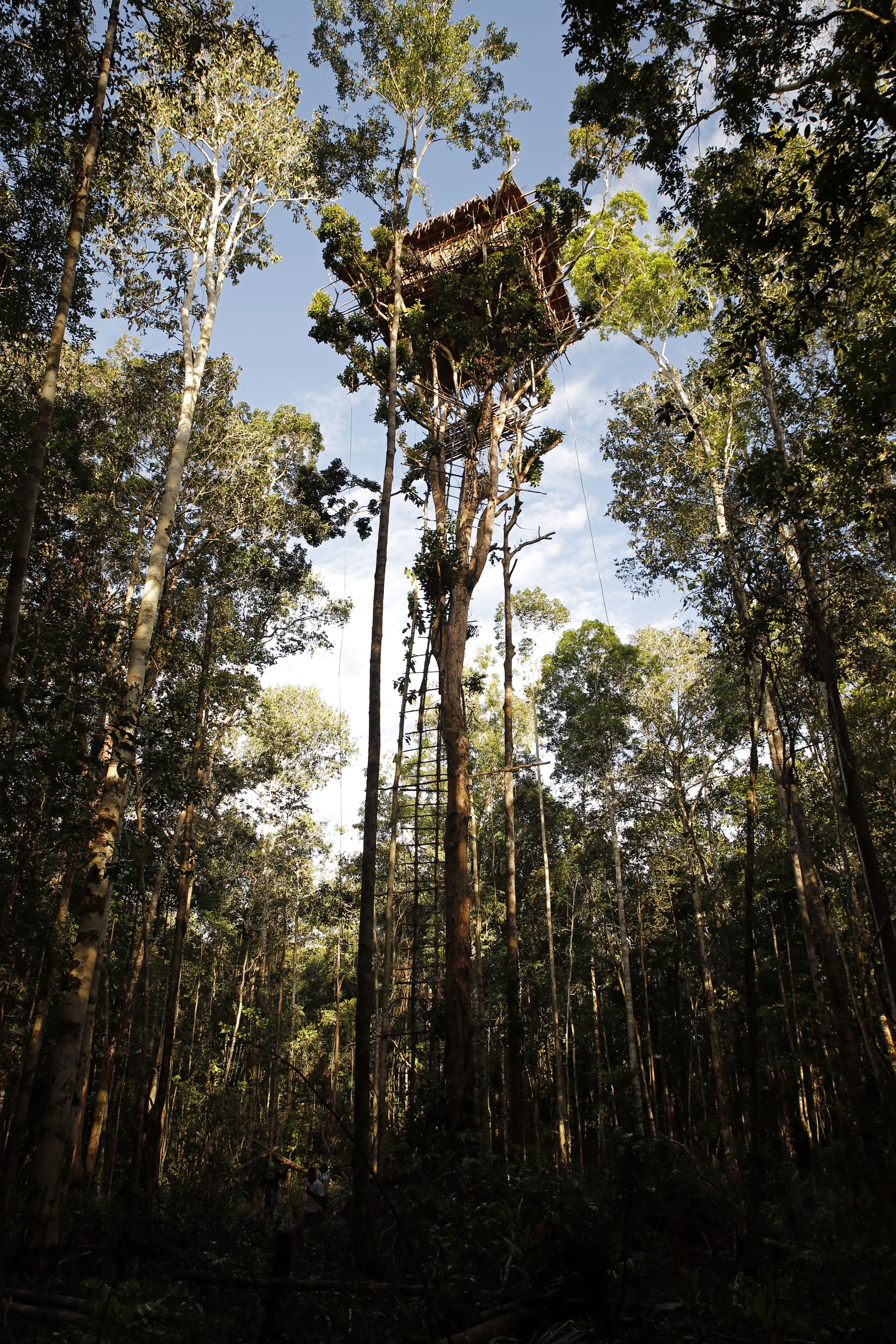
Super-high Korowai treehouse. Credit: AndamanSE, iStock
Super-high Korowai treehouse. Credit: AndamanSE, iStock
“There’s a vast disconnect between representations of Korowai on TV and how they really live,” says Stasch.
He says the notion that Korowai live in harmony with nature, untouched by the modern world is a romantic ideal perpetuated by filmmakers, because they believe it’s what viewers want to see. In 2016 he had the opportunity to help change the media narrative. He was contacted by a filmmaker from UK-based KEO Films who had found Stasch through a Google search while making a new documentary about Korowai for the BBC.
“I described the main patterns of interaction between Korowai and filmmakers, including that Korowai take their clothes off for money. I said ‘They’ll do that for you because that’s what they’ve been told to do by other TV crews,’” says Stasch.
“And the super-high treehouses 100 feet about the ground? Certain Korowai regularly build treehouses at that extreme height for the film crews. But they don’t actually live in them.”
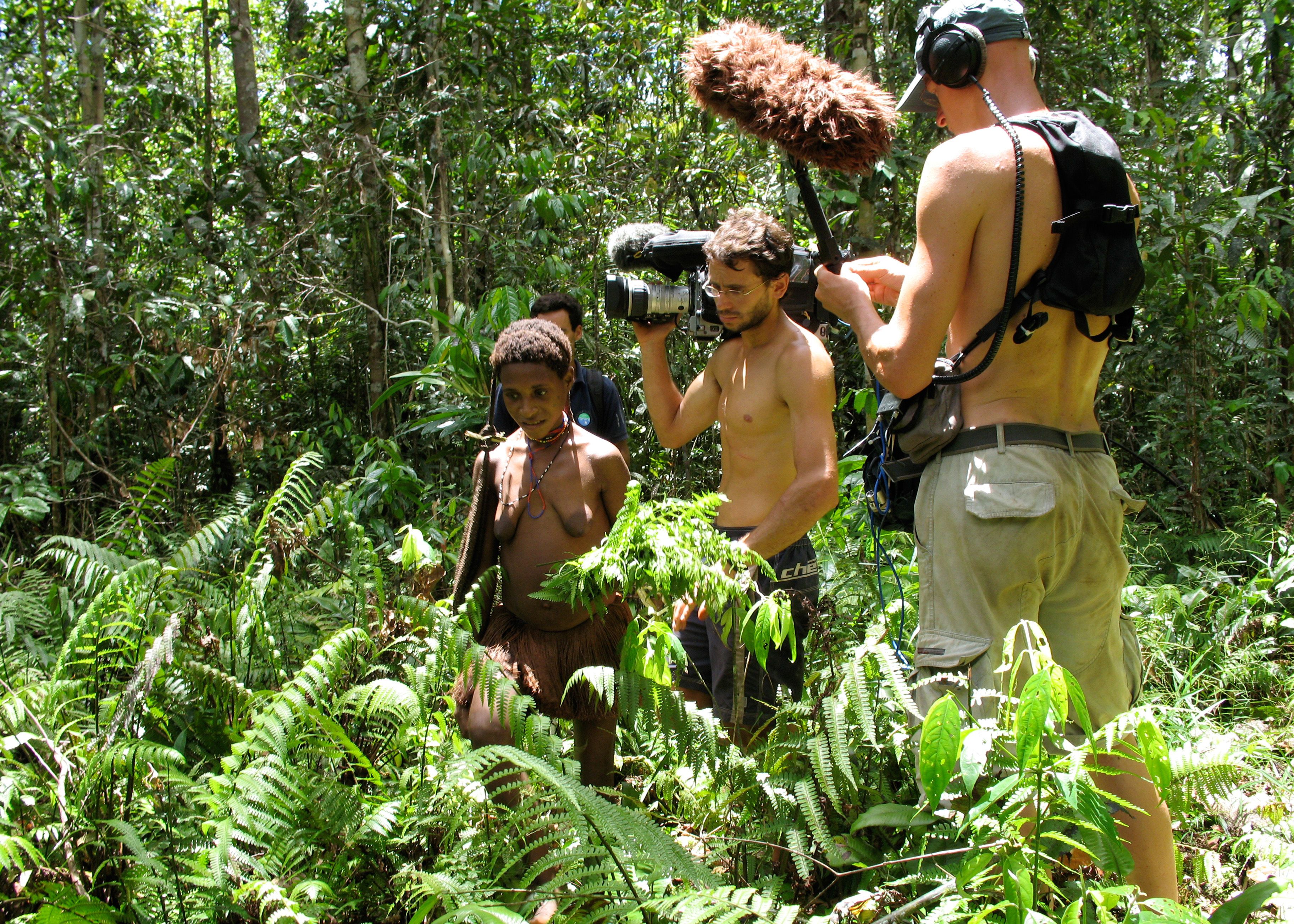
Lemul Manian with a Swiss film crew
Lemul Manian with a Swiss film crew
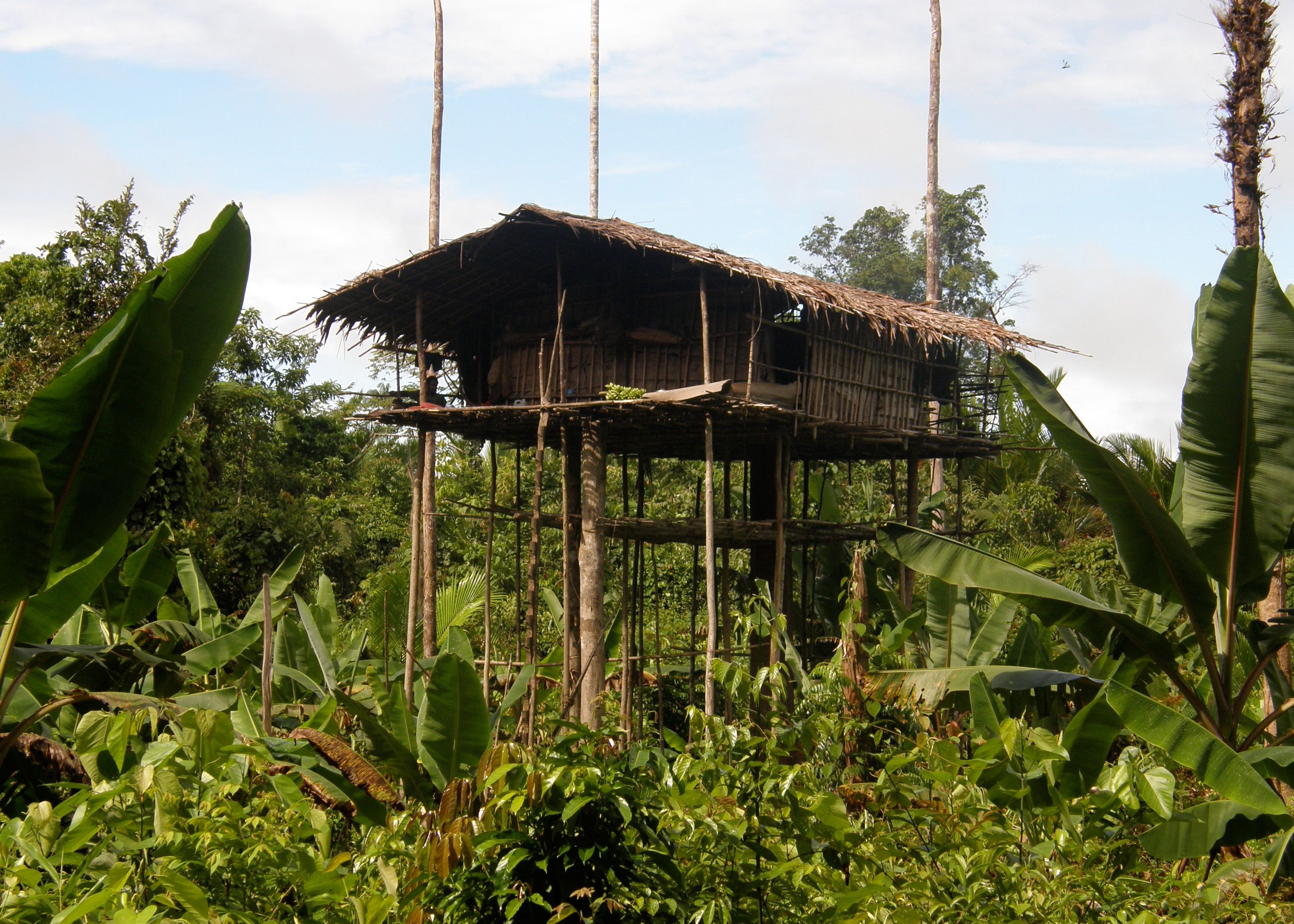
Normal-height Korowai treehouse where a family actually lives
Normal-height Korowai treehouse where a family actually lives
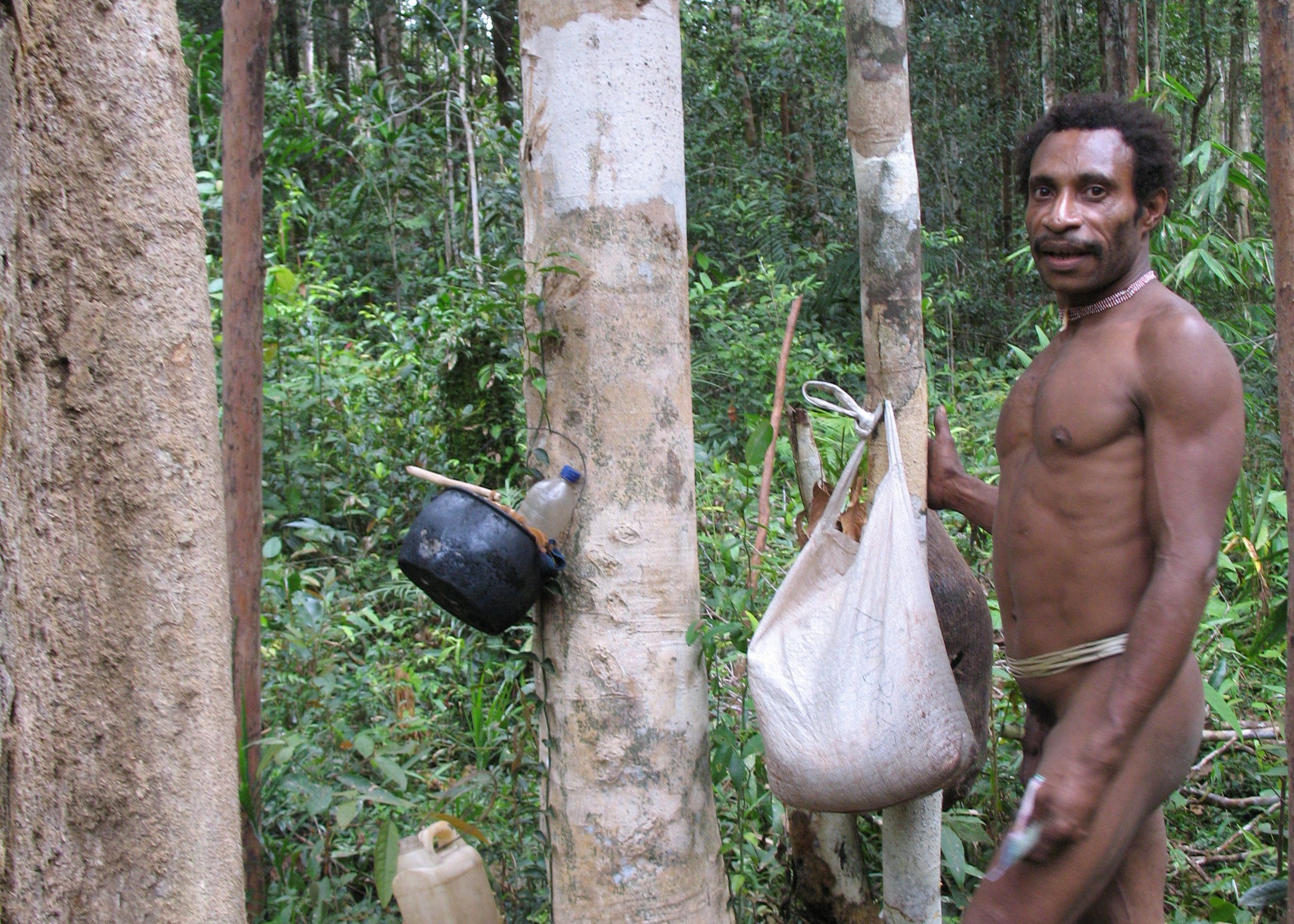
Sahip Bumhai with store bought possessions his family cleared from their treehouse to hide away, before a tour group visited the house earlier that day
Sahip Bumhai with store bought possessions his family cleared from their treehouse to hide away, before a tour group visited the house earlier that day
Rather than perpetuate the myths of previous documentaries, the makers of My Year with the Tribe changed their plans, and drew on Stasch’s expertise and advice to revise their narrative.
But the story goes much deeper than just clothes and treehouses.
“Their show includes a scene where they filmed a Korowai man giving a ‘menu’ of activities he does as cultural performances, and what the prices are,” says Stasch, adding:
“The presenter is distressed to learn that much of what he's seeing is a kind of movie set. Korowai had been staging appearances to match foreigners' romantic desires - but their actual lives are something different and more complex.”

Bailum Helehatun divides out payment after an Austrian group has left. He is also pictured naked, butchering a cooked snake in the opening photo above
Bailum Helehatun divides out payment after an Austrian group has left. He is also pictured naked, butchering a cooked snake in the opening photo above



MORE THAN MONEY
The primary reason Korowai welcome film crews and other international visitors so enthusiastically is for the money they receive. But what might first appear as prior Korowai values being corrupted by money is far more complex, as Stasch’s research has revealed.
“Korowai and international visitors both have culturally elaborate hopes and dreams about each other,” he says. “Each side finds great value in their interaction, often despite mutual incomprehension, and each goes through a degree of learning and transformation in the encounter.”
Although previous generations of Korowai did live in distantly-separated and quite amazing forest treehouses (but typically only 15 feet above ground), the majority now live in permanent villages - and this represents a huge cultural change. They still live in a remote place, but they’re intensely aware of what’s going on in towns and cities - and they want to improve their situation.
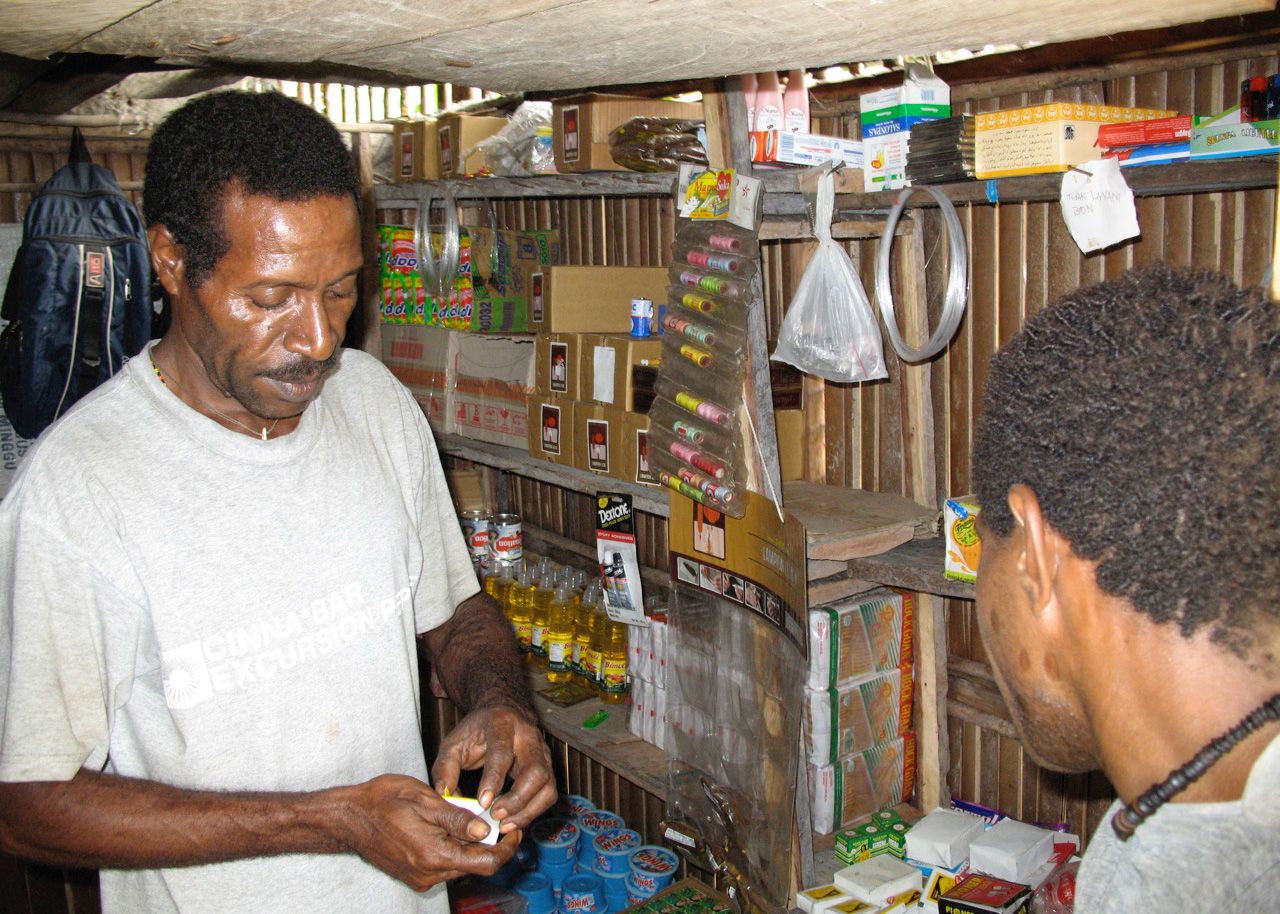
Fenelun Malonggai selling fishing tackle from his family’s store, Yaniruma village
Fenelun Malonggai selling fishing tackle from his family’s store, Yaniruma village
“For Korowai, forming centralised, permanent settlements is about getting access to consumer goods and the market economy; it’s about integrating with the state. To live in villages they have to change their whole ethos from privacy and autonomy and being quick to anger if slighted or bossed around, to seeing socially distant people all the time and getting along amicably,” says Stasch.
Interacting with film crews and tourists is seen by Korowai as integral to this change. Not only are the visitors a means of earning money, they are also a way for Korowai to learn about people different from themselves and build new relationships with the wider world.
“Korowai have worked with so many TV crews and tour groups that they’ve come to view them as one of their most hopeful avenues for improving their situation,” says Stasch.
He adds: “The money they make can buy imported consumer goods, like rice, noodles, steel tools, metal or plastic kitchen goods, and clothing. They also want electronic devices like radios, and although there’s no phone signal they want mobile phones to play songs or games, and take photos they can post to social media when visiting towns.”
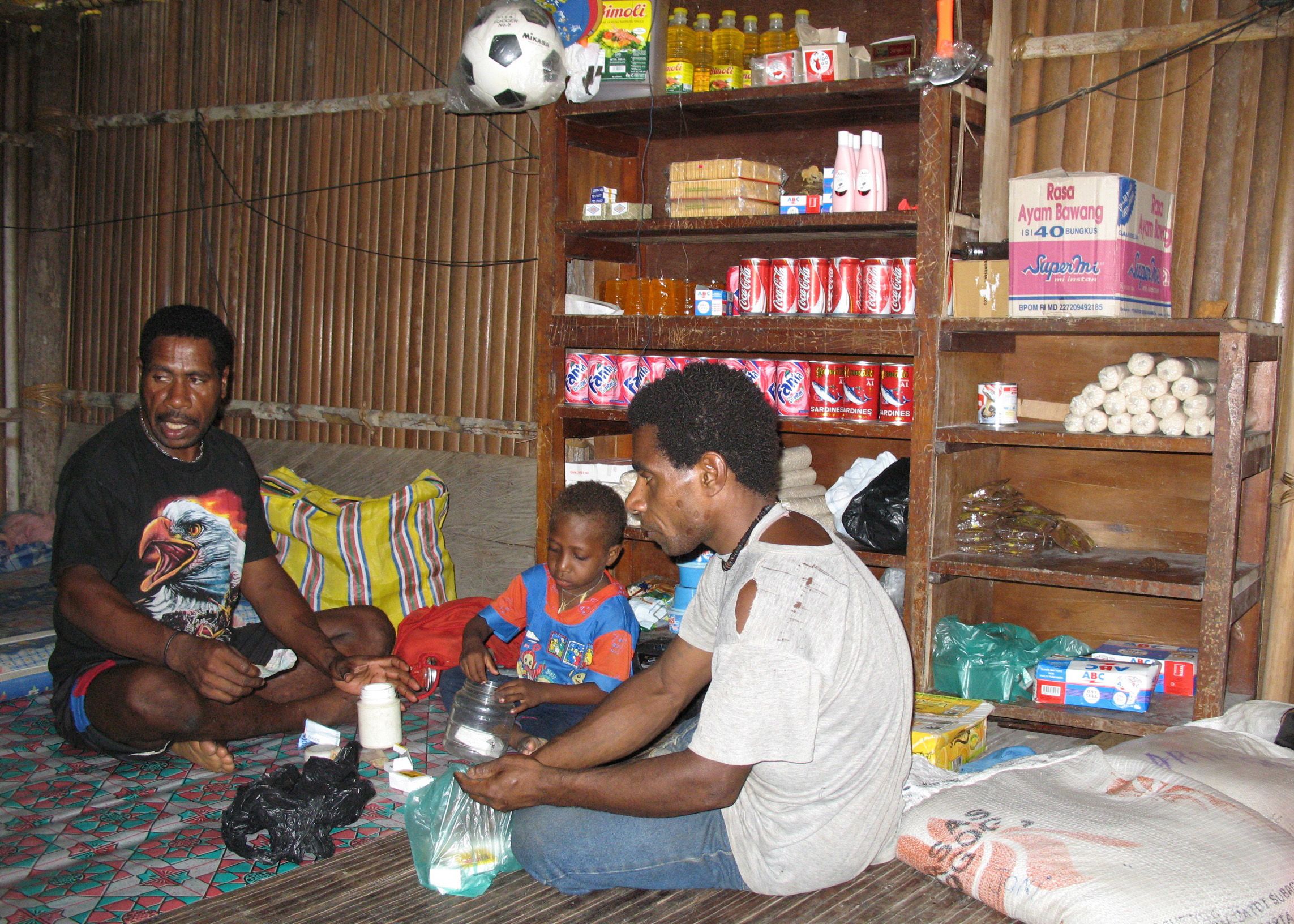
Wayap Dambol buying consumer goods from Ela Malonggai in his house
Wayap Dambol buying consumer goods from Ela Malonggai in his house
Korowai use these goods for kinship purposes. They give store-bought clothes to relatives as an act of love, and they equalise their position in a hierarchy by acquiring things their kin already enjoy. Most importantly, they use money to send their children to school in faraway towns, in the hope of addressing painful new inequalities and improving their collective position.
Every aspect of Korowai life is about kinship relations, Stasch says, including their relationships with foreign visitors. For Korowai, film crews and tourists are part of the overall fabric of what’s going on in their world - not separate observers, as we tend to believe.
“Documentaries are presented as a ‘fly on the wall’ experience - neutral in relation to the world they’re viewing. In reality, film crews completely warp the social and economic space.”
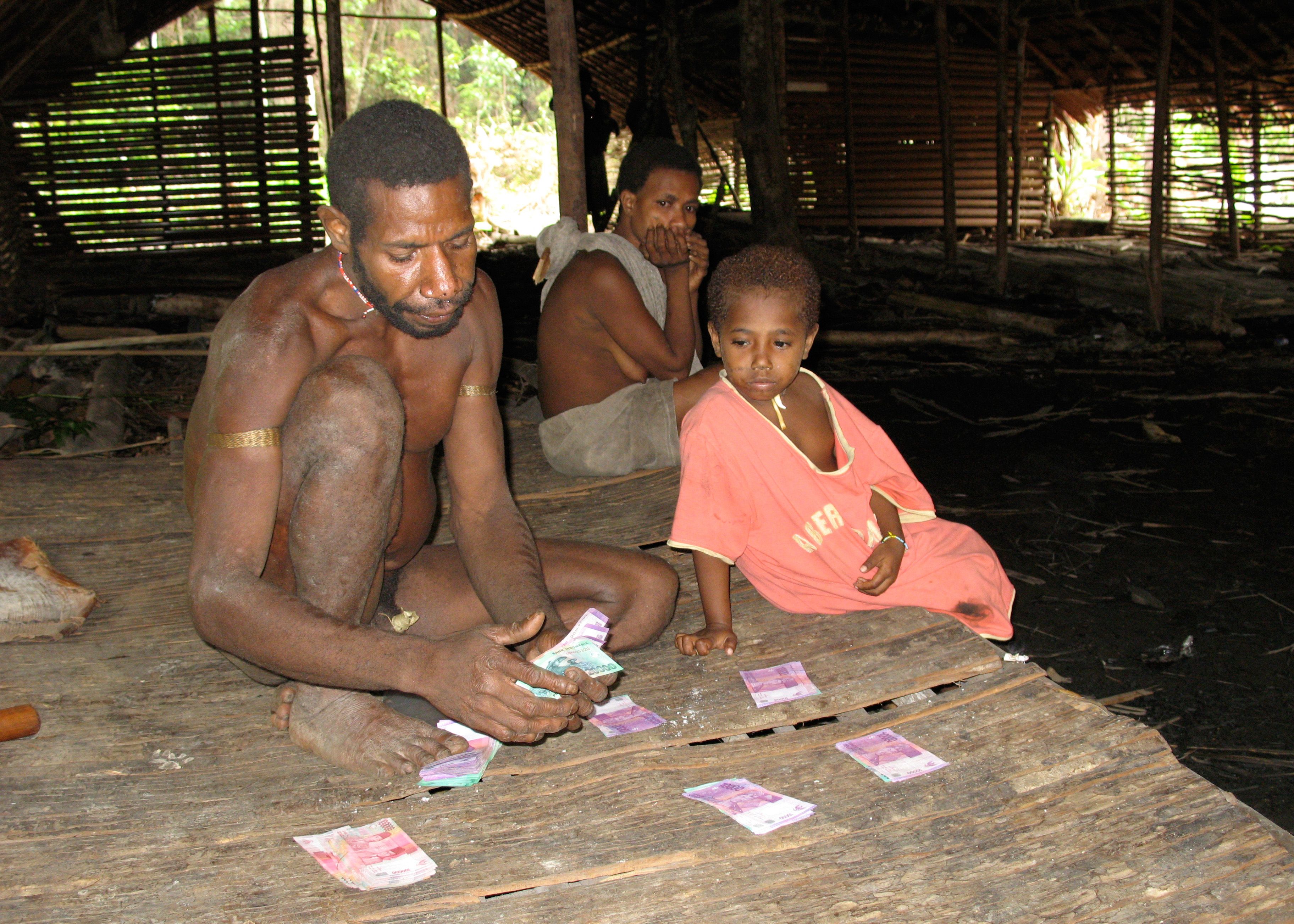
Yakop Dayo dividing out to his relatives the payment left by a Swiss film crew
Yakop Dayo dividing out to his relatives the payment left by a Swiss film crew
Stasch experienced his position as an anthropologist in the same way. But his work has helped to drive improvement in the way Korowai are depicted through mass media. And his knowledge of their language helped capture many cultural subtleties that would otherwise have been lost in the two-step translation from Korowai to Indonesian to English.
PROGRESS FOR ALL
My Year with the Tribe, broadcast by the BBC in 2018, was the first documentary made about Korowai that included scenes about Western visitors’ stereotypes and their clashes with Korowai’s hopes for change.
The filming process was influenced by Stasch’s publications and prior research findings, which he discussed with the director in 2016. The following year he spent ten days in the production company’s editing suites in London, where his expertise in Korowai culture and language helped guide decisions about the show’s content.
Clip from 'My Year with the Tribe', BBC Two, produced by KEO Films. Will meets Amel, who has just given birth on her own in the forest. (Used with the permission of KEO Films).
The three-episode show is also unique in focusing as much on Korowai’s move to village living and their engagement with the market economy, as on their forest-based subsistence. And it is the first to depict Korowai as predominantly wearing imported clothes.
Clip from 'My Year with the Tribe', BBC Two, produced by KEO Films. Agus demonstrates charging a phone with torch batteries and cardboard. (Used with the permission of KEO Films).
“As a result of Stasch’s involvement, our team shifted part of their focus towards documenting how the Korowai have adapted their culture to fit the expectations of film crews and tourists. We knew we were potentially going out on a limb editorially. Dr Stasch’s advice and insight was crucial in our process of developing a series around these new themes, that I believe represents the Korowai culture more accurately and truthfully than other accounts.”
Executive Producer of My Year with the Tribe, KEO Films
The show’s first episode reached an audience of 1.6 million UK viewers, and the series was also broadcast in countries across Europe and in New Zealand. It received two Realscreen Awards for best documentary of the year in its genre, and positive press reviews in mainstream media including BBC News, The Independent, The Guardian, The Spectator and The Express. UK and international audiences have benefited from a more truthful understanding of the lives of Korowai, and other indigenous people in similar circumstances.

The series also sparked great debate about the impact of Western stereotypes on Korowai, and led to the BBC scrutinising the editorial standards of its TV programming. Just as the new show was being broadcast, the BBC withdrew from distribution its prominent 2011 series Human Planet, which misleadingly depicted a Korowai family moving into a very high treehouse as its real home.
“The TV representations were so cartoonish, they needed a reality check,” says Stasch, adding:
“I hope that this work helps future TV crews show some of the complexity of Korowai and their changing ways of life.”
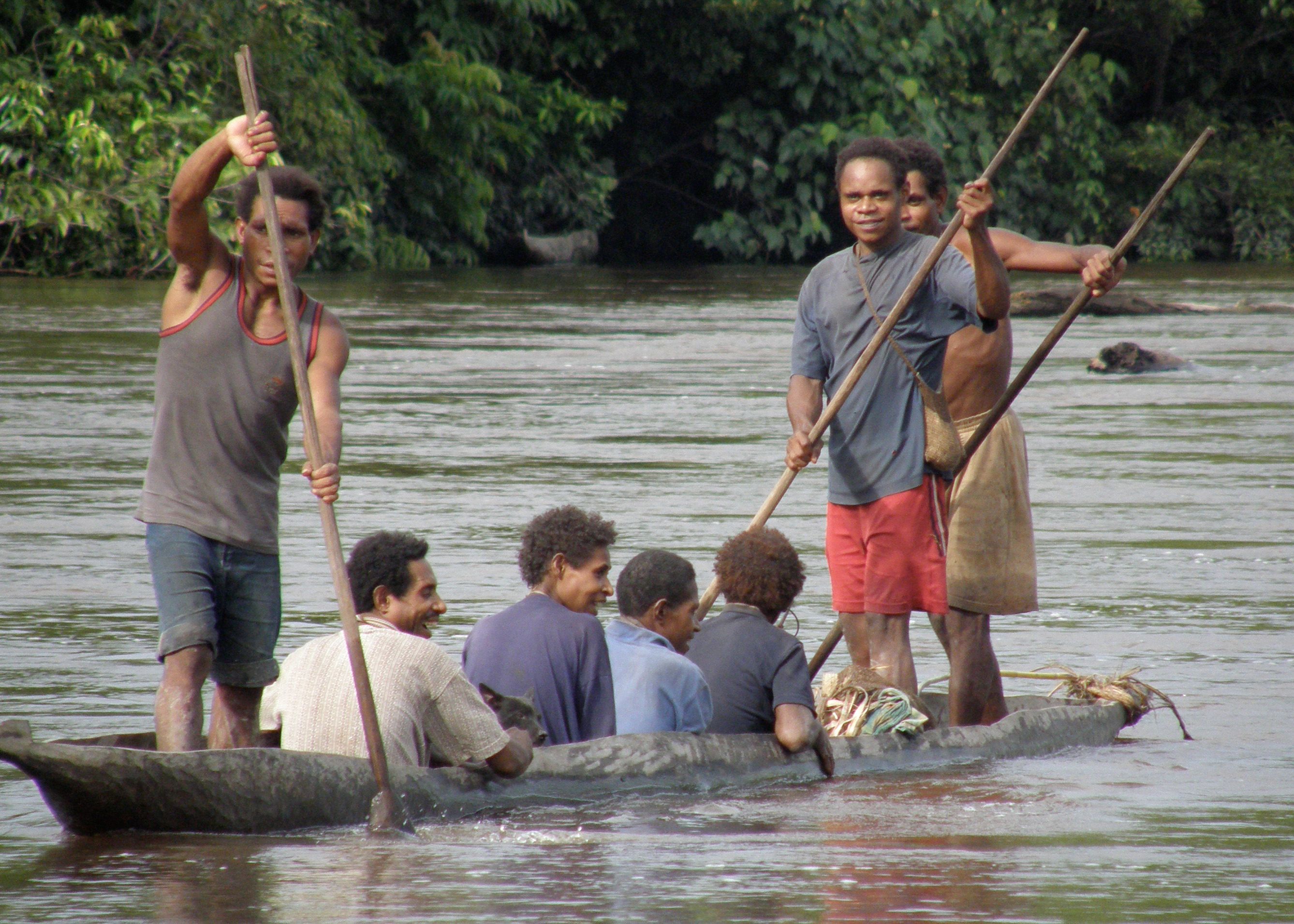
Young canoe owners give another family a lift across the Ndeiram Kabur River
Young canoe owners give another family a lift across the Ndeiram Kabur River

...visit our interactive map to find out how.
Images supplied by Rupert Stasch, unless otherwise noted.
Published December 2021. The text in this work is licensed under a Creative Commons Attribution 4.0 International License.

